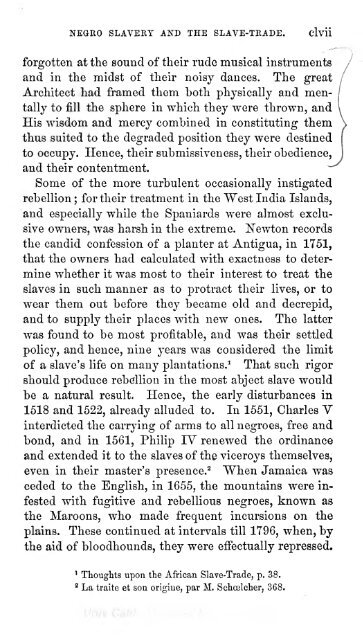Untitled - African American History
Untitled - African American History
Untitled - African American History
Create successful ePaper yourself
Turn your PDF publications into a flip-book with our unique Google optimized e-Paper software.
NEGRO SLAVERY AND THE SLAVE-TRADE. civil<br />
forgotten at the sound of their rude musical instruments /<br />
and in the midst of their noisy dances. The great<br />
Architect had framed them both physically and men- /<br />
tally to fill the sphere in which they were thrown, and \<br />
His wisdom and mercy combined in constituting them \<br />
thus suited to the degraded position they were destined I<br />
to occupy. Hence, their submissiveness, their obedience, J<br />
and their contentment.<br />
Some of the more turbulent occasionally instigated<br />
rebellion ; for their treatment in the West India Islands,<br />
and especially while the Spaniards were almost exclu-<br />
sive owners, was harsh in the extreme. Newton records<br />
the candid confession of a planter at Antigua, in 1751,<br />
that the owners had calculated with exactness to determine<br />
whether it was most to their interest to treat the<br />
slaves in such manner as to protract their lives, or to<br />
wear them out before they became old and decrepid,<br />
and to supply their places with new ones. The latter<br />
was found to be most profitable, and was their settled<br />
policy, and hence, nine years was considered the limit<br />
of a slave's life on many plantations. 1 That such rigor<br />
should produce rebellion in the most abject slave would<br />
be a natural result. Hence, the early disturbances in<br />
1518 and 1522, already alluded to. In 1551, Charles V<br />
interdicted the carrying of arms to all negroes, free and<br />
bond, and in 1561, Philip IY renewed the ordinance<br />
and extended it to the slaves of the viceroys themselves,<br />
even in their master's presence. 2 When Jamaica was<br />
ceded to the English, in 1655, the mountains were in-<br />
fested with fugitive and rebellious negroes, known as<br />
the Maroons, who made frequent incursions on the<br />
plains. These continued at intervals till 1796, when, by<br />
the aid of bloodhounds, they were effectually repressed.<br />
1<br />
Thoughts upon the <strong>African</strong> Slave-Trade, p. 38.<br />
2 La traite et son origiue, par M. Schoelcher, 368.


